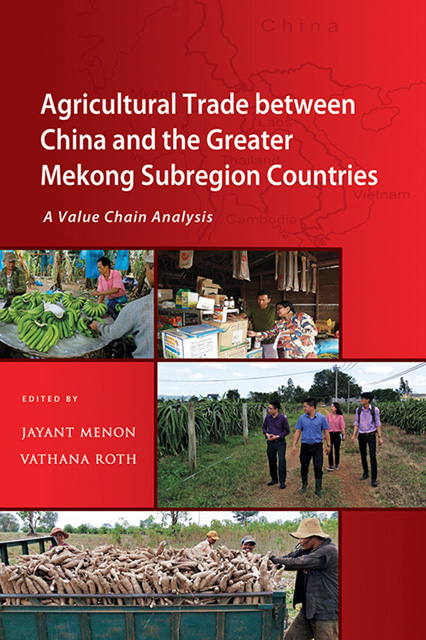Book contents
- Frontmatter
- Contents
- List of Tables
- List of Figures
- List of Annexes
- Foreword
- Preface
- Acknowledgements
- Abbreviations and Acronyms
- The Contributors
- 1 Agricultural Trade between China and the Greater Mekong Subregion Countries: An Overview
- 2 Economic Structural Change in China and the Implications for Agricultural Trade in the Lancang-Mekong Region
- 3 Agricultural Exports from Thailand to China: A Value Chain Analysis of Cassava and Durian
- 4 Agricultural Exports from Cambodia to China: A Value Chain Analysis of Cassava and Sugarcane
- 5 Agricultural Exports from Laos to China: A Value Chain Analysis of Rice and Cavendish Banana
- 6 Agricultural Exports from Myanmar to China: A Value Chain Analysis of Maize
- 7 Agricultural Exports from Vietnam to China: A Value Chain Analysis of Dragon Fruit and Coffee
- Index
6 - Agricultural Exports from Myanmar to China: A Value Chain Analysis of Maize
Published online by Cambridge University Press: 30 June 2023
- Frontmatter
- Contents
- List of Tables
- List of Figures
- List of Annexes
- Foreword
- Preface
- Acknowledgements
- Abbreviations and Acronyms
- The Contributors
- 1 Agricultural Trade between China and the Greater Mekong Subregion Countries: An Overview
- 2 Economic Structural Change in China and the Implications for Agricultural Trade in the Lancang-Mekong Region
- 3 Agricultural Exports from Thailand to China: A Value Chain Analysis of Cassava and Durian
- 4 Agricultural Exports from Cambodia to China: A Value Chain Analysis of Cassava and Sugarcane
- 5 Agricultural Exports from Laos to China: A Value Chain Analysis of Rice and Cavendish Banana
- 6 Agricultural Exports from Myanmar to China: A Value Chain Analysis of Maize
- 7 Agricultural Exports from Vietnam to China: A Value Chain Analysis of Dragon Fruit and Coffee
- Index
Summary
INTRODUCTION
Myanmar shares land borders with China, India, Laos and Thailand. Given this strategic location, the country plays an important role in facilitating trade between China and other Greater Mekong Subregion countries. Myanmar’s trade with China expanded rapidly between the 1990s and the 2010s when the country was still subject to economic sanctions imposed by the United States and the European Union. In 1991–93, China’s share of Myanmar’s trade stood at 24.3 per cent compared to 10 per cent each for the United States and the European Union. At that time, Myanmar traded mostly within the ASEAN region, which accounted for 42.3 per cent of Myanmar’s total trade. By 2011–13, China had become Myanmar’s largest trading partner with a 39 per cent share of total trade, while ASEAN’s share had fallen to just under 29 per cent, and the United States and the European Union each had just 3 per cent.
Although Myanmar continued to rely on natural gas as the main export commodity to Thailand and China, the share of agriculture trade with China rose rapidly in the last ten years. Myanmar’s export portfolio with China mainly consists of raw and unprocessed agricultural products such as rice, beans and pulses, fruit and vegetables, maize, rubber and fishery products. About one-fifth of total agricultural exports are transported overland through cross-border trade to China, though a considerable share of this trade is informal. Here, informal trade refers to trade in processed or non-processed goods considered legal exports on the Myanmar side but illicit imports on the China side. This informal trade represents a massive loss of revenue for Myanmar in value-added and employment opportunities along agricultural value chains. The major bottlenecks behind such imbalance are created by the lack of national quality infrastructure at main border checkpoints and the dominance of informal trade highly susceptible to administrative border control measures. Added to this, the prevalence of non-tariff measures (NTMs) on the China side, and the lack of institutions and infrastructure to certify the quality of agricultural produce on the Myanmar side, are the underlying causes of this informal trade and its negative effects on smallholders.
- Type
- Chapter
- Information
- Agricultural Trade between China and the Greater Mekong Subregion CountriesA Value Chain Analysis, pp. 205 - 255Publisher: ISEAS–Yusof Ishak InstitutePrint publication year: 2022



